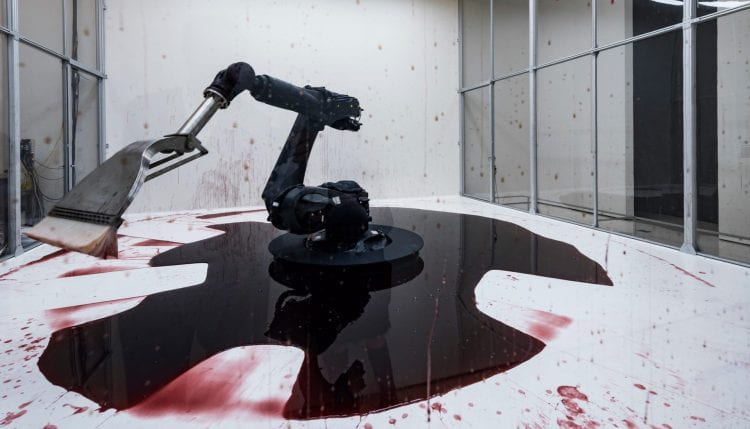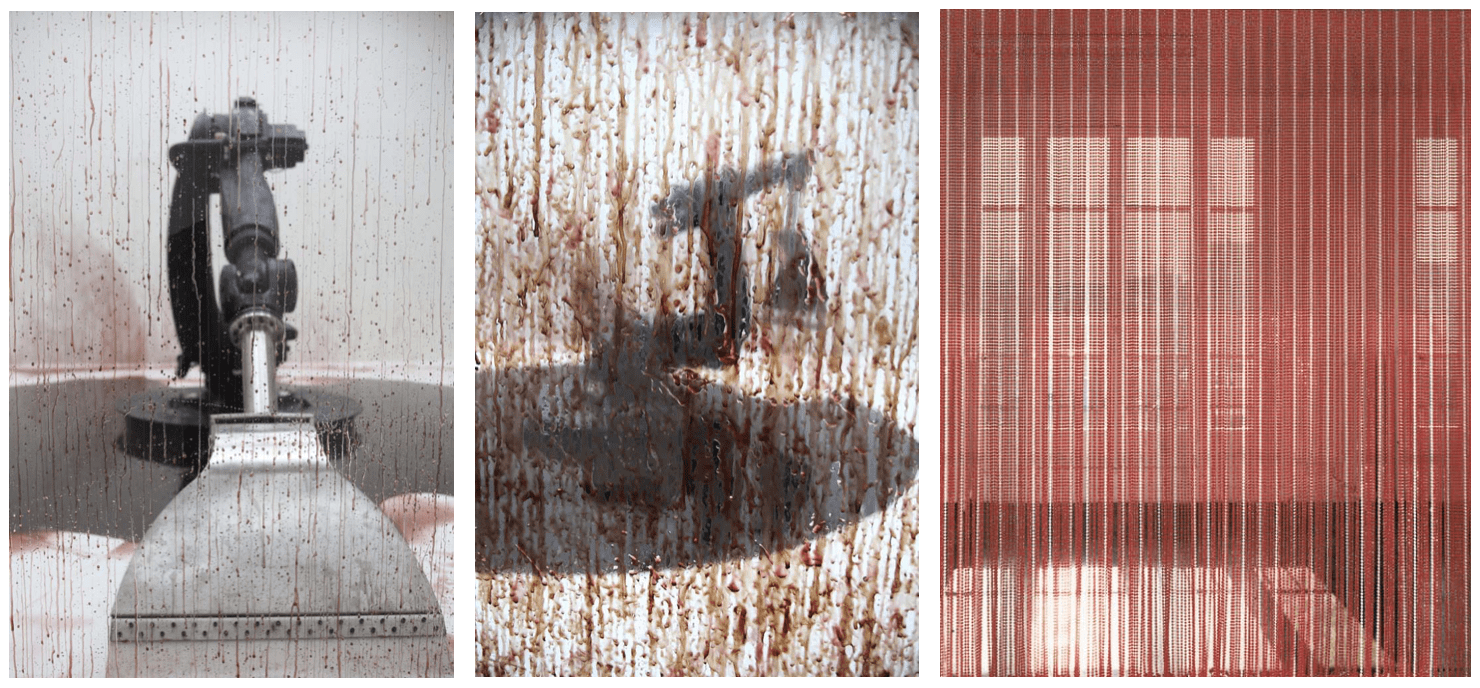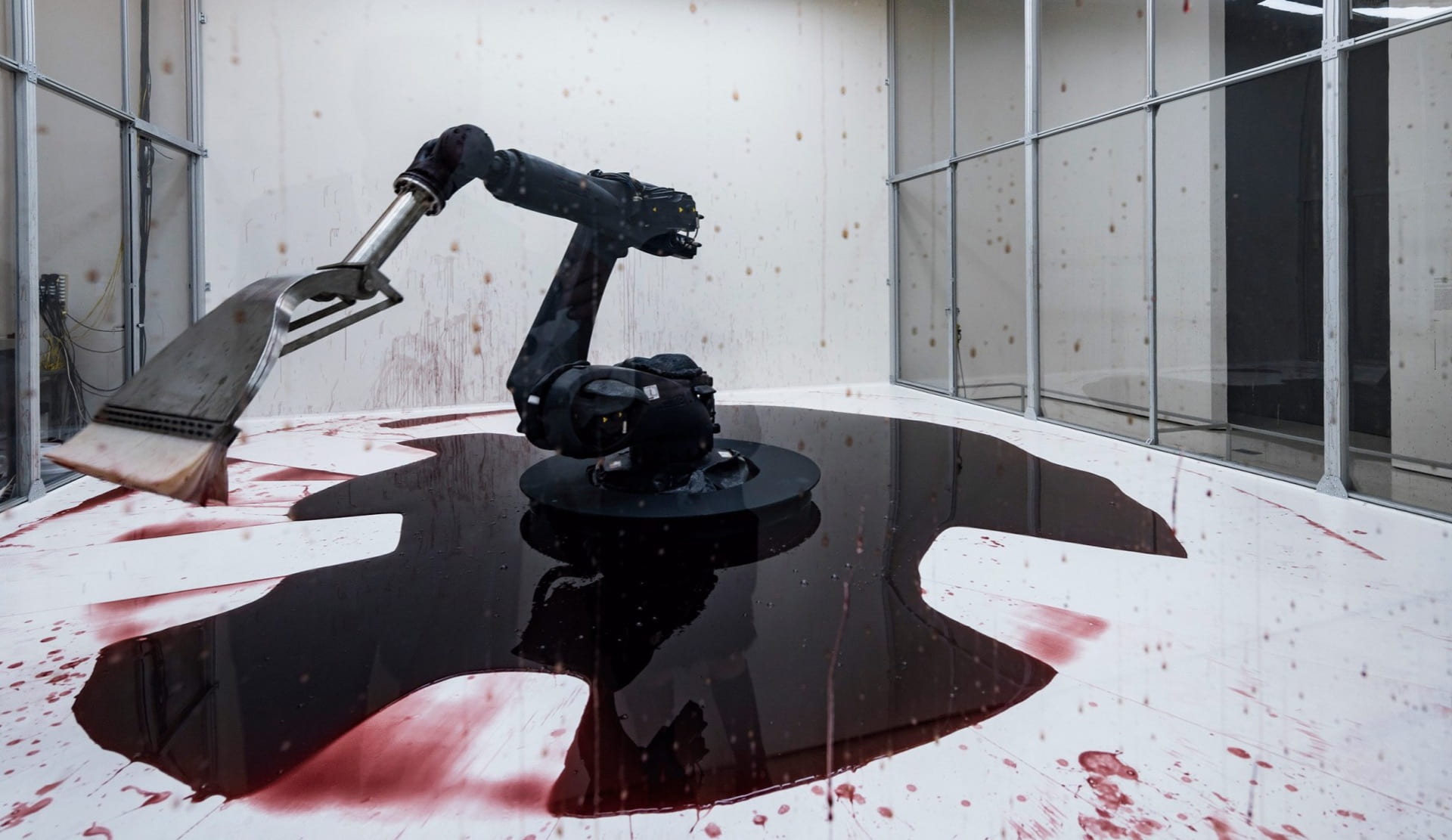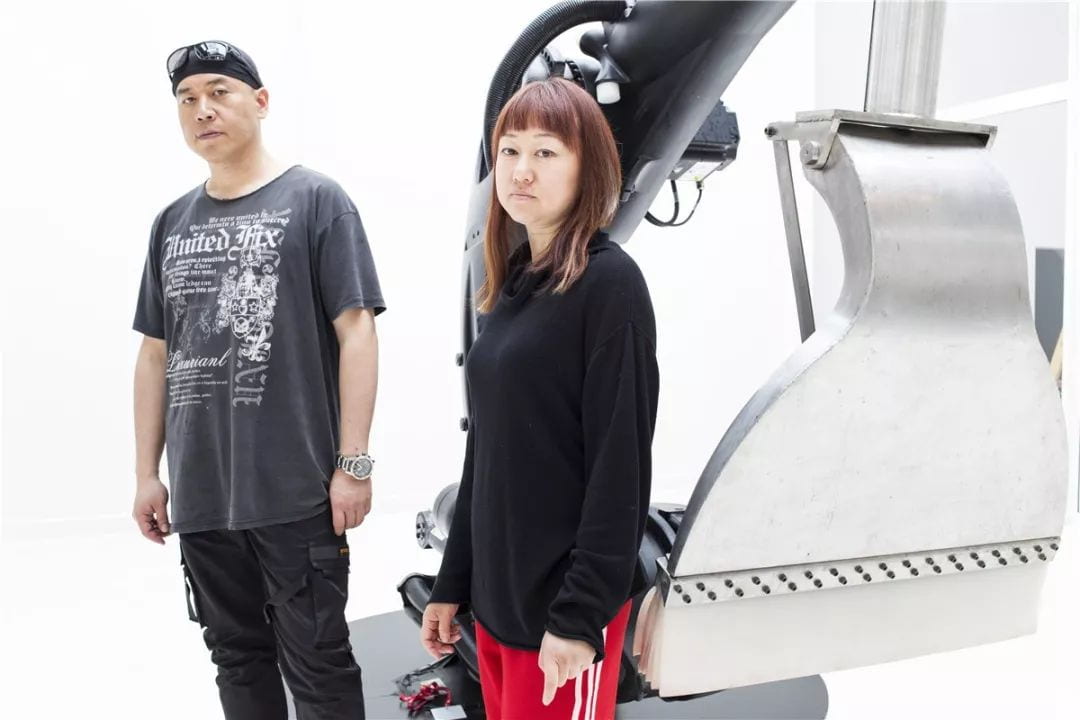
Sun Yuan and Peng Yu: Audience, Agency, and Complicity
Sun Yuan and Peng Yu’s large-scale installation Can’t Help Myself (2016) features an industrial robot made with stainless steel and rubber enclosed in a glass case. On the floor in the case is a pool of a crimson-colored liquid. The robot, which consists of a flat base that is fixed to the floor and a long, crane-like arm, repeatedly bends over in order to sweep up the liquid with the brush attached to its head. A modern-day, industrial Sisyphus, the robot plays a game against the laws of physics that it is doomed to lose. Every time, just as the robot successfully gathers the liquid toward itself, it oozes away and slides down the floor, and the task begins again. As the robot scrubs and sweeps the floor, stray drops of the liquid splash across the acrylic wall in the back and the surface of the case, beyond the perimeter of the robot’s reach. In an effort to clean up its mess, the robot only makes matters worse, but it never stops—it can’t stop itself.
First commissioned by the Solomon R. Guggenheim Museum for its 2016 Tales of Our Time exhibition, Can’t Help Myself subsequently traveled to Venice in 2019, where it was shown at the Central Pavilion of the 58th Venice Biennale “May You Live in Interesting Times.” The exhibitionary contexts for the installation are telling. The Guggenheim show takes its title from a collection of short stories Gu Shi Xin Bian(1936) by Chinese writer and critic Lu Xun, who was a leading figure in modernizing Chinese literature and now widely known for his cutting polemics against outmoded and conservative social values. In Gu Shi Xin Bian, which literally translates to “Old Stories Retold,” Lu Xun rewrites traditional Chinese folktales and subjects their values to modern social critique, rendering literal the age-old adage “history repeats itself.” The title for the Venice Biennale borrows from an apocryphal Chinese saying that is also known as the “Chinese curse,” which uses the term “interesting times” as a sinister euphemism for unrest and turmoil. While the exhibitionary contexts of the installation underline its relationship with the historical and socio-political conditions of China in the age of modernity, however, its aesthetic presentation resists a single unified national identity. In its cold, industrial slickness, the installation does not ally with a specific people or community at all.
It is this slippage of identity—of personhood and of nationhood—that will be the topic of my presentation today. I am interested in how Sun Yuan and Peng Yu mechanize the corporeal as a coy political gesture to at once hint at and evade partisan allegiance, and how they attend to the formal aesthetic quality of the piece to pull in the viewer into an uneasy confrontation: first with the piece, and then with herself. I will divide my presentation into three parts. First, I will provide an overview of Sun Yuan and Peng Yu’s oeuvre and argue that their turn from animal or human flesh to the industrial signals a shift in their understanding of the relationship between the aesthetic object and the viewer. Second, I will compare “Can’t Help Myself” alongside Marina Abramovic’s 1997 performance Balkan Baroque and Felix Gonzalez-Torres’ 1992 installation Untitled (Blood) in order to further tease out the political potential that I identify within the piece. Lastly, I will turn to the critical reception of the artists in an effort to examine, albeit briefly, the stakes of creating political art in modern and contemporary China.
Sun Yuan (b. 1972 Beijing, China) and Peng Yu (b. 1974 Heilongjiang, China) first rose to prominence in the Chinese art scene because of their involvement with the “Shock Art” movement, which flourished in the late 1990s and early 2000s. Shock Art, according to Ros Holmes (2014), is characterized by “its use of highly controversial materials, including body parts, cadavers and live animals.”[i]Wenming Zhu (Civilization Pillar), an early installation by Sun Yuan and Peng Yu, for instance, physically resembles a classical Greco-Roman stone column, but is in fact composed of patches of human fat that the artists collected from cosmetic surgery clinics in Beijing and liquified atop their kitchen stove. Link of the Body (2002) consists of the bodies of a pair of Siamese twins smeared in the blood, staged as a (futile) blood transfusion. And Dogs Which Cannot Touch Each Other (2016), perhaps the piece from the artists that has received the most public attention and controversy, manacles two dogs to two running treadmills facing each other; at the same time that the two dogs endlessly run toward each other, they don’t move an inch, forced to perform hours of pointless labor at the whim of the artists.[ii]
Compared with the bulk of their artistic practice, then, Can’t Stop Myself—along with a few other more recent pieces by the artists—stands out in Sun Yuan and Peng Yu’s oeuvre for its break from what Holmes describes as the artists’ “corporeal aesthetics” and its affinity with the mechanical. I see this break as a sign for the artists’ renewed understanding of the relationship between art and viewer. In more standard practices of Shock Art, the responses that the work of art solicits from the viewer, albeit visceral, are limited and unitary. When faced with bodies of dead babies covered in blood, it is difficult—impossible, even—to react with anything other than disgust, horror, and outrage. The corporeal is still present in Can’t Help Myself—the pool of colored water, for instance, bears an unmistakable resemblance to old, thick, and dried blood—but it is more subdued, and demands more time and attention to parse. Within the tradition of Shock Art, the work of art is used by the artist to assert a statement of uncompromising non-normativity. The viewer is at the mercy of the artist, with no choice but to react in shock and disgust. Can’t Help Myself is still a difficult piece of art, but it also restores the viewer of her interpretative power. As opposed to an immediate and involuntary reaction, the viewer is now invited and, indeed, allowed to behold the installation over an extended period of time and to receive the work on a range of affective registers.
In Can’t Help Myself, the thick, blood-like liquid that is impossible to clean up invokes themes of death, violence, and war. In this regard, I will compare Sun Yuan and Peng Yu’s installation with another piece that shares with it similar themes, Marina Abramovic’ 1997 performance Balkan Baroque, during which the artist sat amidst a pile of cow bones covered in blood and diligently washed them clean one by one, while singing folk songs from her childhood home Yugoslavia—a war-torn country that no longer existed at the time of the performance. Anchored to themes of bloodshed and cleansing, both Can’t Help Myself and Balkan Baroque visualizes the cycle of violence. Where the robot in Can’t Help Myself is subject to endless and futile labor, as she dutifully scrubs away viscera from bone, Abramovic is also increasingly enmeshed within the site of bloodshed. By the end of the performance, the cow bones are all scrubbed and cleaned, and her dress and skin are soaked in blood.
The most obvious difference between the two pieces is that Balkan Baroque physically incorporates the artist’s body into the performance, whereas Can’t Help Myself substitutes the corporeal with the mechanical. As a result, there is a necessary timeframe that brackets Balkan Baroque—the performance often lasts around twenty-six minutes—yet, as long as there is no technical difficulty at the exhibition, the robot in Can’t Help Myself will continue ad infinitum. Another difference between the two is the role of the audience. As the viewer steps into the installation space for Balkan Baroque, the room reeks of rotten cow flesh and the performance is flanked by three projection screens that display the artist’s labor in close detail. The entire piece is set up to enclose the viewer within the affective experience of the artist, who mourns the history and loss of her home country. The viewer sees, understands, and empathizes with the artist’s emotional pain and trauma. By contrast, Can’t Help Myself reads more obliquely. There is a draconian, harsh transactional quality to it: as the machine performs seemingly acontextually, the viewer observes perplexedly. Where Abramovic attempts to wash away the history of injury that afflicts her homeland—a land of the past—it is unclear for whom or for what the robot in Can’t Help Myself performs its task. It is up for the viewer to decide.
By voiding the piece of a specific contextual referent, Sun Yuan and Peng Yu implicate the viewer into the piece: it works as a mirror and reflects back to us the dark underbellies of our consciousness that we usually attempt to neglect. Although the viewer and the robot are separated by the glass case, the viewer is not safe from the scene of violence: drops of blood-like liquid splash across the glass case, and the viewer looks onto the installation through the lens of carnage. The lines of liquid which slide down the glass visually rhyme with the design for Felix Gonzalez-Torres’ 1992 installation Untitled (Blood), which is composed of a curtain made of red plastic beads held from a metal rod, usually set up at the center of the gallery. As a gay artist who witnessed the spread of the AIDS epidemic and whose partner, Ross, eventually succumbed to medical complications related to HIV, Gonzalez-Torres here clearly refers to the bloodshed caused by the virus as well as the thundering public silence around it. By compelling the viewer to physically walk through a curtain of blood drops—the transmitter of HIV—Gonzalez-Torres implicates the viewer into the experience of both living with the virus and being complicit in the silence that exacerbated the epidemic. Similarly, Can’t Help Myself demands that the viewer look at the endless labor of the robot through the filter of bloodshed. Whereas the viewer for Untitled (Blood) must walk through the curtain of red beads in order to access the rest of the gallery, however, the viewer for Can’t Help Myself can easily look away in disinterest or unease. Yet once the viewer comes face-to-face with the tacit violence that underwrites the installation, the act of turning way also takes on a weightier political signification. Couched within the piece is an insidious and uneasy provocation: you can turn away from the installation, but what does it mean to turn away from a blood and guts and violence?

(Left) Sun Yuan and Peng Yu “Can’t Help Myself” 2016 (Middle & Right) Felix Gonzalez-Torres “Untitled (Blood)” 1992
With its oozing pool of blood-like liquid that resists containment, Can’t Help Myself recalls the aftermath of a massacre: the blood that soaks the streets, the effort of the government to contain and purge the incidence from documented history, and the futility of this effort when what is at stake is the ruination of human lives and families. The most obvious example that comes to mind, especially taking into account the fact that both Sun Yuan and Peng Yu have lived and worked in Beijing throughout their career, is the Tiananmen Square Massacre of 1989, during which thousands of protesting students were shot down and murdered: an ugly chapter in modern Chinese history that remains excised from public education curriculum. On a broader level, it could also refer to the continuous implementation of censorship in China that hamstrings free speech and artistic expression within a political context. Or, the representation of a mechanized body toiling away with no end in sight also parallels critiques against underpaid and exploited human labor under an ostensibly socialist nation that leans increasingly toward capitalism. But Sun Yuan and Peng Yu admit to none of the above. What the artists doacknowledge in the public sphere are soundbites that roll off the tongue too easily and glibly, and which are almost entirely disjointed from the difficulty of physically beholding the piece. At the Venice Biennale, for instance, the description for Can’t Help Myself reads: “For Sun Yuan and Peng Yu the uncontrollable liquid that the machine keeps trying to contain conjures what they perceive to be art’s essential elusiveness, its defiant refusal to being pinned down and fixed in place.”[iii]The statement for the Tales of Our Time exhibition at the Guggenheim is more overt, and writes that the works commissioned for the show “examine social and political tensions experienced worldwide, exploring themes such as individual and collective memory, migration and urbanization, cultural inclusion and exclusion, and the contradiction of technological development.”[iv]Yet even when the majority of artists commissioned for the occasion are from China—an obviously deliberate curatorial decision—there is in the museum statement an insistent ambiguity about the context of its politics and social critique. According to the statement, in the exhibition, China is not only a country; rather, it is “a notion that is open for questioning and reinvention.”[v]
The pitfalls of opening up the work of art to a range of interpretive and emotional responses are that institutional structures can just as easily erase from discourse the difficult histories that the artists are grappling with in their practice. Although Sun Yuan and Peng Yu consistently deploy shock as an aesthetic statement, their conspicuous political quietude has generated much controversy. The shock factor of much of their work, which often border on horrific, amoral, and antisocial, has rarely interfered with their success in the Chinese art world. For Link of the Body, the installation which features the bodies of two Siamese twin infants, Sun Yuan and Peng Yu won the 2002 young artist prize in the Contemporary Chinese Art Awards. Whereas some critics take this as evidence for the cultural differences in taste and understandings of decency between China and the West, others argue that this underlines the artists’ complicity with the state-organized violence that their work seems to polemicize.[vi] As long as they do not explicitly and publicly pillory the government—as artists such as Ai Weiwei have done—they are allowed free reign in their art.
The relationship between art and politics has always been fraught: on one hand, art, inevitably, is always political; on the other hand, to create art that is explicitly political is to also render the artist more vulnerable to state surveillance and potentially violence.[vii] It seems that art either avoids or takes on politics head-on; there is no in-between. Sun Yuan and Peng Yu’s Can’t Help Myselfpresents one possible alternative. Similar to their earlier works, the polemical license of Can’t Help Myselfis dubious; yet, by attenuating the primacy of shock, Sun Yuan and Peng Yu also gives the work more texture and complexity. At the same time that it evokes the elusiveness of art itself or social and political tensions in the age of globalization, it also brings to mind state-sponsored and censored violences that follow most of modern Chinese history. It is up for the viewer to decide which interpretation to favor and which to repress. Although titled “Can’t Help Myself,” it is unclear whether this is a complaint made from the perspective of the robot (“I can’t help myself but to clean”) or the audience (“I can’t myself but to look away”). Or, perhaps it is a joke made at the expense of the critic: viewers like me who can’t help myself but to read into the work of art, who can’t help but hope that art will be more political, who can’t help but believe that art has the potential to change the world.
At the end of my presentation, I hope to finish with an anecdote about John Cage, even though he seems at first glance unlikely bedfellows with Sun Yuan and Peng Yu. When discussing his most famous composition 4.33, in which musicians are not allowed to perform any of their instruments out loud, Cage recalls entering into an anechoic chamber at Harvard University: a room designed to be as silent as possible.[viii] In the room, however, he heard two sounds, one high and one low, which he was later informed were the sounds of his nervous system in operation and his blood in circulation: there is no such thing as total silence, what is silent is only what we choose to neglect. In 4.33, the true site of performance is not the staged silence of the musicians, but rather the myriad of sounds and noise in the background that the audience would usually ignore. Like 4.33, then, although Can’t Help Myself does not explicitly articulate its political intent—in fact, it seems to purposefully avoid the subject—its suggestive visual qualities invite the viewer to take the extra step and to connect the dots. In its performance of political silence, it amplifies the sound of our own complicity. If we can’t help but turn away from histories of injury and violence, then, at the very least, we can confront and admit to our own bad faith.
Cecily Chen 2019
Notes:
[i]Ros Holmes, “Pillars of Fat: The Corporeal Aesthetics of Civilization (Wenming) in Contemporary Art” The China Journal, 72 (July 2014) 123
[ii]For an example of the blowback against the piece from animal activist groups, see Edward Helmore, “Can mistreated dogs ever be considered art?” The Guardian, September 17, 2017. https://www.theguardian.com/world/2017/sep/can-mistreated-dogs-ever-be-considered-art
[iii]Exhibition description for Can’t Help Myself, Sun Yuan and Peng Yu. Central Pavilion, Giardini Della Biennale, May You Live in Interesting Times. Venice, Italy. May 11, 2019-November 24, 2019.
[iv]Exhibition description for Tales of Our Time, curated by Xiaoyu Weng and Hou Hanru. The Solomon R. Guggenheim Museum, New York. November 4, 2016-March 10, 2017. https://www.guggenheim.org/exhibition/tales-of-our-time
[v]Ibid
[vi]Mary Bittner Wiseman, “Subversive Strategies in Chinese Avant-Garde Art” The Journal of Aesthetic and Art Criticism, 65.1 (Winter 2007) 109-110
[vii]For more on the political ambiguity of Chinese art in an international market, see Noël Carroll, “Art and Globalization: Then and Now” The Journal of Aesthetics and Art Criticism 65.1 (Winter 2007) 131-143
[viii]John Cage, Silence: Lectures and Writings(Hanover, NH: Wesleyan University Press, 1961) 8


